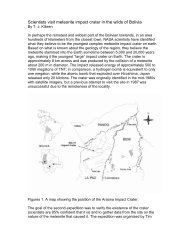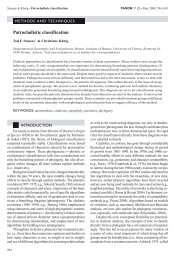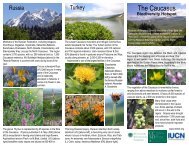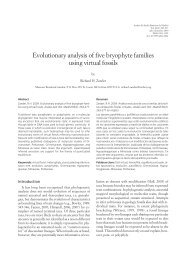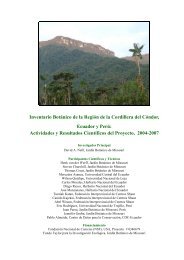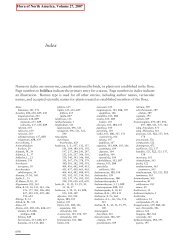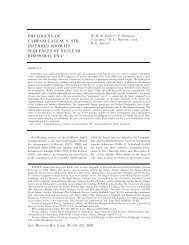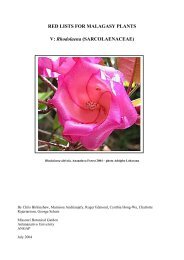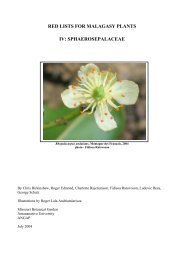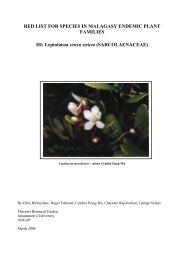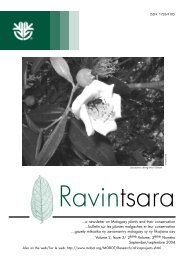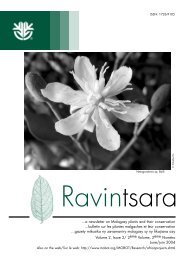re-evaluation of tortella - Missouri Botanical Garden
re-evaluation of tortella - Missouri Botanical Garden
re-evaluation of tortella - Missouri Botanical Garden
You also want an ePaper? Increase the reach of your titles
YUMPU automatically turns print PDFs into web optimized ePapers that Google loves.
ag<strong>re</strong>e about this species." He put T. nitida in the genus<br />
Trichostomum in the basis <strong>of</strong> the p<strong>re</strong>sence <strong>of</strong> a stem<br />
central strand.<br />
The type specimen <strong>of</strong> Tortella nitida strongly<br />
<strong>re</strong>sembles the autoicous Tortella humilis except for the<br />
massive costa, in section with two well-developed<br />
ste<strong>re</strong>id bands. It is perhaps because <strong>of</strong> this that<br />
Limpricht (1890) wonde<strong>re</strong>d whether T. nitida might<br />
possess axillary male buds. Tortella nitida differs from<br />
T. humilis immediately by its long stem and elongate<br />
habit, rather than the typically much shorter stem and<br />
rosulate habit <strong>of</strong> T. humilis. The cross section <strong>of</strong> T.<br />
humilis in the middle <strong>of</strong> the leaf is adaxially flat.<br />
Although the type <strong>of</strong> T. nitida has leaves that appear<br />
adaxially flat, most specimens a<strong>re</strong> mo<strong>re</strong> tubulose, with<br />
margins e<strong>re</strong>ct and broadly incurved. Although both<br />
species have gradually intergrading proximal cells,<br />
those <strong>of</strong> T. nitida a<strong>re</strong> mo<strong>re</strong> strongly intergrading: the<br />
marginal cells in the proximal a<strong>re</strong>a a<strong>re</strong> mo<strong>re</strong><br />
conspicuously set <strong>of</strong>f as a border <strong>of</strong> lax-walled,<br />
elongate, hyaline epapillose cells, in some specimens so<br />
<strong>re</strong>duced as to cast doubt that the specimen is a Tortella<br />
at all. Tortella nitida ra<strong>re</strong>ly fruits and has short, e<strong>re</strong>ct<br />
peristome teeth, whe<strong>re</strong>as T. humilis, at least in North<br />
America, is ra<strong>re</strong>ly found without fruit, and its peristome<br />
teeth a<strong>re</strong> long and in one or two spirals.<br />
Tortella nitida has a distinctive growth-form:<br />
in hemispherical cushions, rather like some Grimmia<br />
species, and is f<strong>re</strong>quently <strong>re</strong>p<strong>re</strong>sented in herbarium<br />
specimens as fan-shaped slices from the original polster.<br />
None <strong>of</strong> the species <strong>of</strong> Tortella that occur in North<br />
America assume this shape except T. inclinata var.<br />
densa.<br />
Tortella nitida has f<strong>re</strong>quently been described as<br />
having a "white" or "pale" costa. Its costa seems,<br />
however, to be in color no diffe<strong>re</strong>nt than others in the<br />
genus, except that the costa itself is mo<strong>re</strong> prominent<br />
than in other species, especially when the laminae a<strong>re</strong><br />
folded together when dry and the whole clump <strong>of</strong> leaves<br />
p<strong>re</strong>sent their broad backs to view. This whiteness or<br />
paleness appa<strong>re</strong>ntly is in <strong>re</strong>fe<strong>re</strong>nce to the "gloss" due to<br />
the smoothness <strong>of</strong> the costal abaxial surface. The costae<br />
<strong>of</strong> all species in the genus a<strong>re</strong> yellow or yellow-brown<br />
to orange.<br />
The leaf cross section in highly colo<strong>re</strong>d<br />
specimens <strong>of</strong> Tortella nitida shows a palisade <strong>of</strong><br />
quadrate papillose cells on the adaxial surface <strong>of</strong> the<br />
costa forming a g<strong>re</strong>en layer over the orange costa,<br />
confluent with the g<strong>re</strong>en color <strong>of</strong> both laminae. The 1-3<br />
bistratose pairs <strong>of</strong> guide cells, or incompletely bistratose<br />
guide cell layer, is characteristic <strong>of</strong> Pseudosymblepharis<br />
and some species <strong>of</strong> Trichostomum (Zander 1993).<br />
Specimens from Europe show Tortella nitida<br />
to give little indication <strong>of</strong> its placement in Tortella<br />
except for a narrow border <strong>of</strong> about two to several cells<br />
width <strong>of</strong> elongate, thin-walled, smooth hyaline cells,<br />
otherwise the proximal cells a<strong>re</strong> all thick-walled,<br />
colo<strong>re</strong>d and gradually become diffe<strong>re</strong>ntiated from the<br />
distal laminal cells. Sometimes the hyaline border is<br />
46<br />
wider and distinct, <strong>re</strong>sembling that <strong>of</strong> Plerurochaete<br />
squarrosa (Brid.) Lindb.<br />
The fragility <strong>of</strong> the leaf <strong>of</strong> Tortella nitida <strong>of</strong>ten<br />
exp<strong>re</strong>sses itself in moderately scalloped or lobed<br />
margins, with indentations at points <strong>of</strong> laminal fragility.<br />
The leaves fragment in <strong>re</strong>ctangular units and along the<br />
length <strong>of</strong> the costa such that in many older leaves the<br />
stem is invested with naked costae divested <strong>of</strong> the<br />
laminae.<br />
None <strong>of</strong> the common ovate-lanceolate-leaved<br />
Trichostomum species have fragile leaves.<br />
Trichostomum tenuirost<strong>re</strong>, in North Temperate stations,<br />
may have fragile, tatte<strong>re</strong>d generally long-linear leaves<br />
with a sprawling, loosely tufted habit, occurring with or<br />
without a stem central strand. Tortella alpicola is<br />
similarly fragile and is separated by its diminutive size,<br />
large leaf cells and propagulum at the leaf tip. It is this<br />
fragility that helps to distinguish ambiguous specimens<br />
<strong>of</strong> Tortella nitida from Trichostomum brachydontium or<br />
Tr. crispulum, since some specimens <strong>of</strong> the latter<br />
species may show a tendency toward mo<strong>re</strong> delicate cells<br />
on the margins <strong>of</strong> an otherwise intergrading proximal<br />
cell <strong>re</strong>gion.<br />
Although most <strong>re</strong>gional floras do not mention<br />
it, neither Trichostomum crispulum nor Tr.<br />
brachydontium a<strong>re</strong> tomentose except at the base, and in<br />
this characteristic Tortella nitida is similar.<br />
William Mitten's isotype (NY) <strong>of</strong><br />
Trichostomum diffractum Mitt., now included in the<br />
synonymy <strong>of</strong> Tortella nitida, was also examined and,<br />
although <strong>re</strong>p<strong>re</strong>senting rather smaller plants with<br />
narrower leaves, perhaps characteristic <strong>of</strong> immaturity, it<br />
matches Lindberg's type. Other collections made by<br />
Mitten in Britain also closely <strong>re</strong>semble the Lindberg<br />
type.<br />
The description and illustration <strong>of</strong> fruiting<br />
material he<strong>re</strong> is taken from a single specimen:<br />
Dalmatian plants collected by Jul. Baumgartner 16/III<br />
1904 (S). Clearly the description and illustration <strong>of</strong> the<br />
peristome <strong>of</strong> this specimen in the p<strong>re</strong>sent manuscript<br />
does not match what is described by the following<br />
sources: "peristome teeth short, rather imperfect, very<br />
slightly oblique" (Dixon 1924); "peristome short, <strong>of</strong><br />
rather imperfect, very slightly oblique, yellowish,<br />
papillose teeth" (Haring 1938); "Teeth <strong>of</strong> the peristome<br />
very short and ir<strong>re</strong>gular, truncate, yellow, papillose"<br />
(Braithwaite 1887). Mönkemeyer (1927) also indicated<br />
that the peristome <strong>of</strong> Tortella nitida was rudimentary.<br />
Limpricht (1890), in addition, <strong>re</strong>ported that the cells <strong>of</strong><br />
the operculum we<strong>re</strong> straight, the peristome was<br />
rudimentary, yellow-<strong>re</strong>d and smooth, although Philibert<br />
described the teeth as papillose, the basal tube scarcely<br />
or not at all exserted, the teeth linear, scarcely<br />
developed, the longest to 0.07 mm. He appears to have<br />
seen a fruiting specimen, although the species<br />
appa<strong>re</strong>ntly did not fruit in Germany, Austria or<br />
Switzerland.<br />
The peristome teeth in Braithwaite's illustration<br />
(1887: pl. 37 and <strong>re</strong>produced by Haring in Grout 1938:<br />
169, pl. 81) a<strong>re</strong> very short with <strong>re</strong>spect to the capsule





